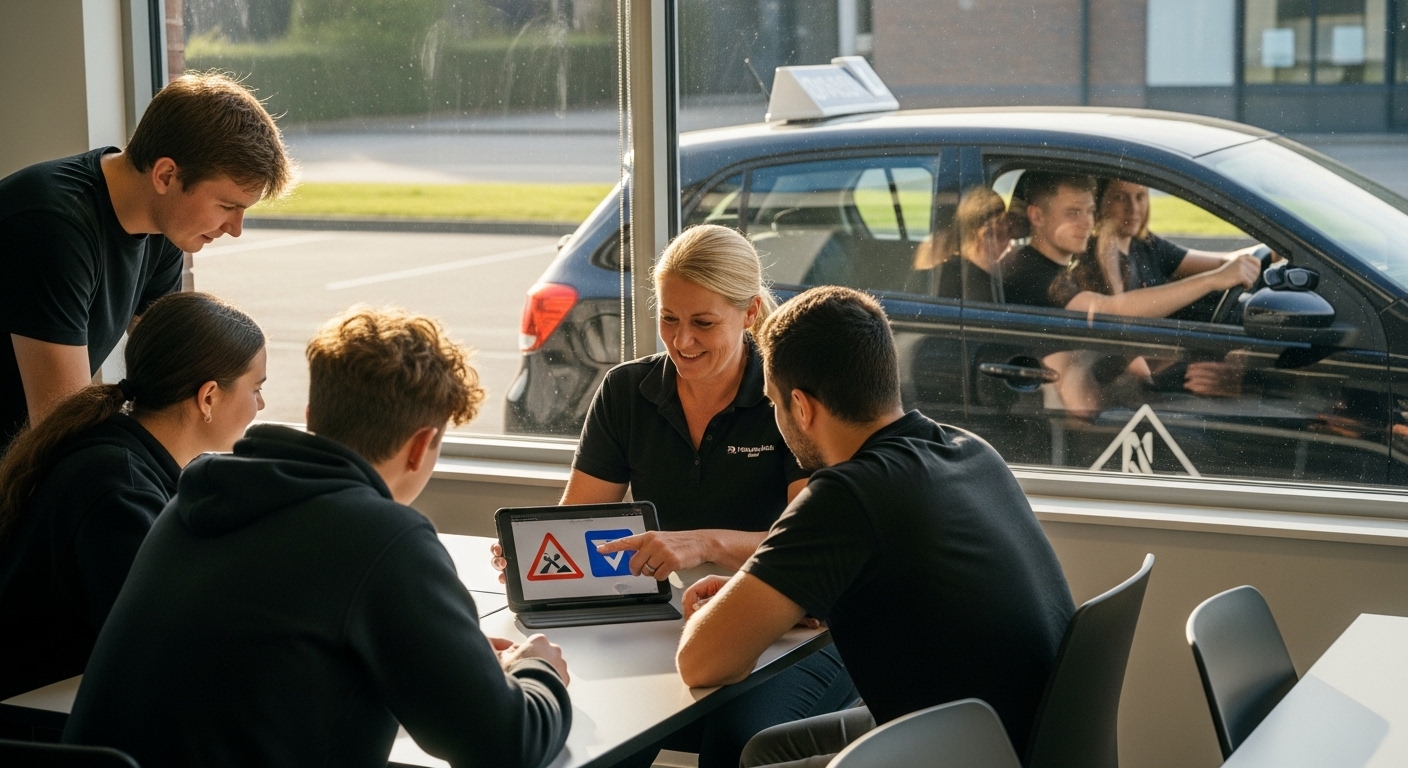Mastering the art of driving always begins with a rigorous study of the Highway Code, the essential guide to safe driving. And yet, in France, less than 60% of candidates pass their Code exam on the first try– a surprising figure. It’s not a question of memorization, but of understanding and, above all, of applying the rules astutely in everyday life. Here are 7 ways to learn how to drive.
Table of contents
- Understanding the basics of the highway code
- Choose a learning method adapted to your needs
- Take lessons with a qualified instructor
- Practice defensive driving in real-life situations
- Use applications and tools for learning
- Evaluate your progress regularly
- Prepare for your driving test efficiently
Quick summary
| Awareness | Explanation |
|---|---|
| Master the Highway Code | Understand the logic of the rules to ensure your safety and that of others. |
| Adapt your learning method | Choose an approach that suits your learning style to maximize efficiency. |
| Choose the right instructor | An experienced instructor will guide you, bringing personality and adaptation to your specific needs. |
| Practice defensive driving | Anticipate dangers and adopt proactive driving to prevent accidents. |
| Regularly assess your progress | Track your successes and areas for improvement to become a competent and confident driver. |
1: Understanding the basics of the Highway Code
Learning to drive begins with a solid understanding of the Highway Code, a set of essential rules and regulations that guarantee the safety of all road users. This legal document defines not only the behavior expected of drivers, but also the consequences of non-compliance.
Key elements of the Highway Code to know
As you prepare to get your driver’s license, mastering the Highway Code becomes your first strategic mission. It’s not just about memorizing the rules, but understanding their logic and importance for road safety.
Here’s what you need to know:
- Road signs and their meaning
- Priority rules in different traffic situations
- Speed limits for different types of road
- Safety distances
- What to do in an emergency
According to Legifrance, the Highway Code precisely defines the learning conditions and obligations of future drivers. These regulations are designed to create responsible drivers who are aware of road safety issues.
Learning to apply the rules
Theory is not enough. Understanding also means applying it. Every rule in the Highway Code is designed to protect road users. By gradually integrating them, you’ll develop not only your knowledge, but also your safety reflex.
To succeed, focus on understanding rather than simply memorizing. Visualize situations, anticipate behavior and integrate rules as natural driving reflexes.
2: Choose a learning method adapted to your needs
Every learner is unique, and finding the right driver training method for you is essential to your success. Don’t dive headlong into a standardized program without taking into account your personal preferences and learning style.
Learning method indicators
To help you identify the learning style that’s right for you, here’s a list of questions you can ask yourself:
- Do you prefer detailed explanations or hands-on learning?
- Do you retain better by watching demonstrations or listening to explanations?
- Do you like to learn alone or in a group?
- Do you need to manipulate and experiment to understand?
The key lies in an honest self-assessment of your abilities and approach to learning. Some people assimilate information better visually, others through practice or listening.
Learning approaches
According to Driiven, there are several learning approaches to suit different learner profiles:
- Experiential learning: focused on practice and direct experimentation
- Visual learning: using graphics and demonstrations
- Active practice: learning through repetition and simulation
- Mutual learning: interacting and sharing with other learners
- Project-based learning: solving real-life scenarios
The aim is not to find a perfect method, but the one that suits you best. Don’t hesitate to talk to your instructor to personalize your learning path.
Choosing the right method is already an important step towards your driving licence success. Listen to yourself and don’t be afraid to adapt your approach along the way.
3: Take lessons with a qualified instructor
A qualified driving instructor is your most important partner on the road to obtaining your license. He or she is not simply someone who teaches you to drive, but a professional who will guide you with expertise and safety.
The relationship with your instructor is crucial. It’s not simply a transmission of knowledge, but a personalized accompaniment that will enable you to develop not only technical skills, but also a real awareness and a responsible attitude on the road.
Qualities of a good instructor
To identify a good instructor, there are a few criteria to consider:
- Official, up-to-date certification
- Proven experience in driving instruction
- The ability to adapt to different learner profiles
- An unfailing patience and pedagogy
- Clear, friendly communication
According to PubMed, professional instructors use a progressive, integrative approach. They break down complex driving tasks into simpler steps, gradually transferring responsibility to the student.
Methods applied by a professional intructor
During your lessons, expect :
- Detailed explanations before each maneuver
- Practical demonstrations
- Constructive feedback after each exercise
- Personalized support adapted to your level
A good instructor won’t just tell you how to drive, but will help you understand why certain rules and techniques are essential. He or she will develop your safety reflex well beyond simple technical gestures.
Choose your instructor as you would a coach: carefully, based on his or her ability to understand you and help you progress. Your driving license will be the result of this collaboration.
4: Practice defensive driving in real-life situations
Defensive driving is much more than a technique, it’s a state of mind that can literally save your life. Contrary to popular belief, it’s not about being fearful on the road, but about being constantly vigilant and proactive.
Your main objective: to prevent accidents before they happen. This means developing an acute perception of your road environment and anticipating the potentially dangerous behavior of other drivers.
Principles of defensive driving
The fundamental principles of defensive driving include:
- Constantly observing your environment
- Maintain a safe distance
- Avoid distractions (phone, GPS)
- Anticipate the reactions of other users
- Adapt your speed to traffic conditions
According to the Association Prévention Routière, defensive driving is based on three essential pillars: anticipation, vigilance and self-control.
Defensive driving practices
Defensive driving involves applying specific measures at the wheel. Here are some practical examples:
- Scan your field of vision regularly
- Use your mirrors frequently
- Always have an emergency exit
- Make your intentions clear
- Stay calm even in the face of aggressive drivers
One effective technique is to always have a plan B. Constantly imagine potential scenarios: what would you do if a vehicle suddenly appeared? How would you react to a distracted pedestrian?
Defensive driving is not a constraint, but an intelligent strategy for your safety. It allows you to transform the road into a serene, controlled cruising area, where you remain in control even in unexpected situations.
Remember: on the road, the best defense is a preventive attack based on vigilance and composure.
5: Using applications and tools for learning
Learning to drive has evolved considerably thanks to digital technologies. Modern applications and tools now offer interactive, personalized learning methods that can be accessed at any time.
These technological resources do not replace traditional teaching, but are an effective complement to it. They allow you to reinforce your theoretical knowledge, practice virtual situations and track your progress precisely.
Specific features of innovative learning technologies
Key features of digital learning tools include:
- Accessible 24/7
- Learning at your own pace
- Real-life simulations
- Mock tests and instant assessments
- Personalized progress monitoring
According to the GADGET study, self-assessment and personal reflection are essential to modern learning. Driving applications integrate these principles perfectly, offering interactive tools that encourage critical analysis.
Recommended applications
Here are the main learning-to-drive applications:
- Highway code preparation applications
- Virtual driving simulators
- Mapping and navigation tools
- Progress tracking applications
- Online training modules
The best digital tools are characterized by their ability to make learning fun and engaging. They transform what could be perceived as a constraint into an interactive and motivating experience.
To maximize their effectiveness, use these applications as a complement to your practical lessons. They can’t replace the experience of a professional instructor, but they can significantly speed up your learning.
Choose recent, regularly updated applications that comply with the latest regulations and driving standards. Your objective: to master not only the technology, but also the philosophy of responsible driving.
6: Evaluate your progress regularly
Continuous assessment is the key to transforming passive learning into dynamic, conscious progress. It’s not simply a grading exercise, but a strategic tool for understanding your strengths and identifying areas for improvement.
Regular assessment allows you to objectively measure your learning journey, going beyond subjective impressions. Each session becomes an opportunity for growth, where you learn as much from your mistakes as from your successes.
Key indicators to monitor
To assess your progress, here are a few key indicators:
- Technical mastery of vehicle controls
- Compliance with traffic regulations
- Confidence in driving
- Managing stress in complex situations
- Anticipating potential risks
According to a study on driver training, self-assessment and feedback from instructors are crucial components in developing genuine driving skills.
Practical assessment strategies
To succeed in your evaluations, adopt good techniques such as :
- Keep a log of your progress
- Ask for detailed feedback after each lesson
- Compare your performance in different situations
- Identify your weaknesses objectively
- Set precise improvement targets
The aim is not immediate perfection, but constant progress. Each evaluation should enable you to understand not only what you can do, but above all how you can improve.
Your instructor will be your main ally in this process. Listen to his or her advice, ask questions, and be open to constructive criticism. A receptive attitude will turn every evaluation into a learning opportunity.
Remember: assessment is not a judgment, but a development tool. Use it wisely to become a safer, more confident and more responsible driver.
7: Prepare for your driving test effectively
Driving test day can seem daunting, but with strategic preparation, you can turn stress into confidence. Your goal is not to become a perfect driver, but to demonstrate that you are a responsible and competent driver.
Mental preparation is just as important as technical preparation. Visualize yourself passing the test, mastering each maneuver with calm confidence.
Key elements to master before the exam
To ensure success at the exam, it is essential to pay attention to the following points:
- Vehicle technical checks
- Seat and mirror adjustments
- Perfect knowledge of controls
- Stress management
- Precise understanding of instructions
According to California DMV, effective preparation rests on three pillars: review, practice and confidence.
Practical preparation the day before the exam
Take the time to prepare well before the big day. This means :
- Check all necessary documents
- Sleep well
- Eat a light breakfast
- Arrive 30 minutes early
- Wear comfortable clothes
During the test, focus on the essentials: strict compliance with the Highway Code, clear communication with the examiner, fluid movements and constant anticipation.
Avoid classic mistakes: don’t focus solely on technical perfection, but demonstrate your ability to drive safely and responsibly. The examiner is assessing your overall behavior, not just your mechanical skills.
Remember: confidence is built through preparation. Breathe, stay calm and trust yourself. You’ve worked hard to get here.
Summary of learning methods
Here’s a table summarizing the 7 main methods for successfully learning to drive, their objectives and benefits according to the article.
| Method | Main objective | Key benefits |
|---|---|---|
| Understanding the Highway Code | Master the rules and their logic for safety | Develop safety reflexes, in-depth understanding |
| Choose the right learning method | Adapt training to your own style | Optimize progress, boost motivation |
| Take lessons with a qualified instructor | Personalized support and expertise | Accelerate progress, boost confidence |
| Practice defensive driving | Prevent accidents through anticipation and vigilance | Reduce risks, ensure proactive driving |
| Use digital applications and tools | Reinforce learning with interactive resources | Personalized follow-up, learning flexibility, better memorization |
| Regularly assess progress | Measure and continually improve skills | Enables training to be adjusted, develops autonomy |
| Efficient exam preparation | Optimize your chances of success through strategic preparation | Manage stress, ensure safe, controlled performance |
Go from theory to success with Auto-École Lémanique
Would you like to apply the 7 methods of learning to drive in practice and finally pass your driving test? Many learners feel overwhelmed by the theory, hesitate when faced with a choice of tools, or lack confidence at exam time. At Auto-École Lémanique in Geneva, we understand that every learner experiences these difficulties: lack of real practice, incomprehension of the Highway Code, or stress in an assessment situation. Our team offers you personalized support, flexible timetables and complete preparation, from the code to practical lessons in traffic.

Need to make rapid progress or feel ready for your driving test? Choose a tailor-made course with our certified instructors and discover our solutions at
Frequently asked questions
How can I learn the Highway Code effectively?
To learn the Highway Code effectively, it’s essential to understand the rules rather than memorize them. Use visual aids, mock tests and mobile applications to reinforce your learning.
Which learning-to-drive method is best for me?
Identify your learning style: visual, auditory, kinesthetic, etc. Talk to your instructor to customize your method to suit your needs and preferences.
Why is it important to have a qualified driving instructor?
A qualified instructor brings not only technical skills, but also an adapted teaching approach. He or she will help you develop a responsible attitude on the road and improve your driving reflexes.
What are the strategies for effective defensive driving?
For defensive driving, maintain a safe distance, stay alert, anticipate the behavior of other road users and avoid distractions. These practices reduce the risk of accidents and increase your safety on the road.





